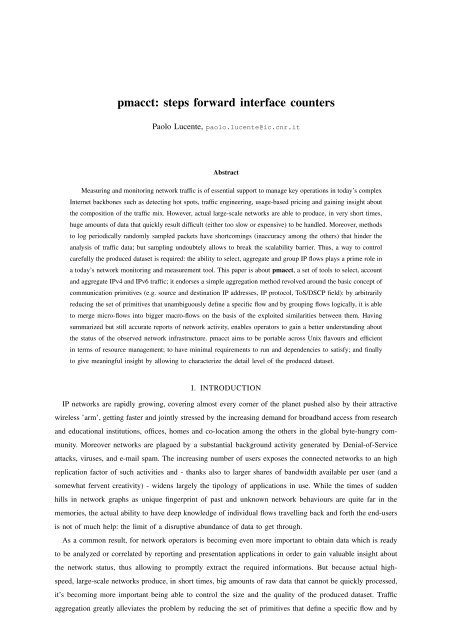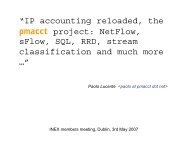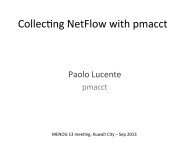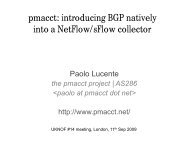pmacct: steps forward interface counters
pmacct: steps forward interface counters
pmacct: steps forward interface counters
You also want an ePaper? Increase the reach of your titles
YUMPU automatically turns print PDFs into web optimized ePapers that Google loves.
<strong>pmacct</strong>: <strong>steps</strong> <strong>forward</strong> <strong>interface</strong> <strong>counters</strong><br />
Paolo Lucente, paolo.lucente@ic.cnr.it<br />
Abstract<br />
Measuring and monitoring network traffic is of essential support to manage key operations in today’s complex<br />
Internet backbones such as detecting hot spots, traffic engineering, usage-based pricing and gaining insight about<br />
the composition of the traffic mix. However, actual large-scale networks are able to produce, in very short times,<br />
huge amounts of data that quickly result difficult (either too slow or expensive) to be handled. Moreover, methods<br />
to log periodically randomly sampled packets have shortcomings (inaccuracy among the others) that hinder the<br />
analysis of traffic data; but sampling undoubtely allows to break the scalability barrier. Thus, a way to control<br />
carefully the produced dataset is required: the ability to select, aggregate and group IP flows plays a prime role in<br />
a today’s network monitoring and measurement tool. This paper is about <strong>pmacct</strong>, a set of tools to select, account<br />
and aggregate IPv4 and IPv6 traffic; it endorses a simple aggregation method revolved around the basic concept of<br />
communication primitives (e.g. source and destination IP addresses, IP protocol, ToS/DSCP field): by arbitrarily<br />
reducing the set of primitives that unambiguously define a specific flow and by grouping flows logically, it is able<br />
to merge micro-flows into bigger macro-flows on the basis of the exploited similarities between them. Having<br />
summarized but still accurate reports of network activity, enables operators to gain a better understanding about<br />
the status of the observed network infrastructure. <strong>pmacct</strong> aims to be portable across Unix flavours and efficient<br />
in terms of resource management; to have minimal requirements to run and dependencies to satisfy; and finally<br />
to give meaningful insight by allowing to characterize the detail level of the produced dataset.<br />
I. INTRODUCTION<br />
IP networks are rapidly growing, covering almost every corner of the planet pushed also by their attractive<br />
wireless ’arm’, getting faster and jointly stressed by the increasing demand for broadband access from research<br />
and educational institutions, offices, homes and co-location among the others in the global byte-hungry community.<br />
Moreover networks are plagued by a substantial background activity generated by Denial-of-Service<br />
attacks, viruses, and e-mail spam. The increasing number of users exposes the connected networks to an high<br />
replication factor of such activities and - thanks also to larger shares of bandwidth available per user (and a<br />
somewhat fervent creativity) - widens largely the tipology of applications in use. While the times of sudden<br />
hills in network graphs as unique fingerprint of past and unknown network behaviours are quite far in the<br />
memories, the actual ability to have deep knowledge of individual flows travelling back and forth the end-users<br />
is not of much help: the limit of a disruptive abundance of data to get through.<br />
As a common result, for network operators is becoming even more important to obtain data which is ready<br />
to be analyzed or correlated by reporting and presentation applications in order to gain valuable insight about<br />
the network status, thus allowing to promptly extract the required informations. But because actual highspeed,<br />
large-scale networks produce, in short times, big amounts of raw data that cannot be quickly processed,<br />
it’s becoming more important being able to control the size and the quality of the produced dataset. Traffic<br />
aggregation greatly alleviates the problem by reducing the set of primitives that define a specific flow and by
grouping flow primitives into larger network entities (for example individual IP addresses into either network<br />
prefixes or Autonomous Systems); this methodology allows to merge micro-flows into bigger macro-flows, also<br />
referred as aggregates, on the basis of the exploited similarities between them while continuing to preserve the<br />
required traffic detail. Intuitively, the new degree of similarity between the flows is established by the number<br />
of primitives into the reduced set. Summarized traffic reports are of valuable support for a range of critical<br />
operations like but not limited to determining the busiest segments of the network, thresholding sudden network<br />
events, monitoring the well-provisioning of the underlying infrastructure, SLA monitoring. Moreover, the ability<br />
to tag packets offers the opportunity for the deployment of innovative billing schemes (e.g., location-based)<br />
beyond the usage-based ones.<br />
Some important requirements are at the root of a today’s good passive monitoring software design: speed<br />
(the ability to deal smoothly high link rates), scalability (by allowing more sensors to work cooperatively in a<br />
distributed fashion) and an high degree of flexibility (by allowing to characterize the details of the produced<br />
dataset). <strong>pmacct</strong> has been developed with these goals in mind and more efforts have been pushed in developing<br />
and mantaining a clean architecture that allows for quick processing of incoming network data basing also over<br />
the observation that the computing speed will, in the very next future, no more compare favourably to network<br />
speed, further reducing the number of cycles available before the next packet arrives (the cycle budget) which<br />
is already almost minimal in today’s networks[6].<br />
II. BRIEF CONCEPTS<br />
Let’s give a definition of the primitives and their properties, applied to <strong>pmacct</strong> context:<br />
• a primitive is a keyword that identifies a specific portion of the headers’ stack of a packet,<br />
• each keyword is unique into the alphabet: no two keys are identified by the same name,<br />
• each portion of the stack is represented by just one keyword and viceversa,<br />
• the portion identified by a keyword is strictly disjoint by any other portion identified by another keyword.<br />
A flow definition is made of a group of primitives, plus few <strong>counters</strong> (e.g., bytes and packets counter). Let’s<br />
now define the concept of flow: it is a group of packets that share the same instantiation of the flow definition.<br />
Basing on this, we will introduce the concept of flow aggregation as it is seen in <strong>pmacct</strong>. Let’s give our first<br />
flow definition, µFlow, the following way:<br />
µF low{src host, dst host, ip proto, src port, dst port, sum(bytes), sum(packets)}<br />
in real world, such grouping may represent a typical unidirectional group of packets transiting through the<br />
Internet and carrying a transport protocol like TCP or UDP. Let’s assume, for the ease of our discussion, that<br />
values of both src host and dst host primitives are static; we will be able to obtain such behaviour by applying<br />
a filter (going practical again, such filter would enable us to count the packets transiting between two specific<br />
hosts). Then, generating some traffic for a time δ, we will populate Setα of j packets transiting between the<br />
two hosts; by applying our µFlow definition to the produced Set j α, we will be able to classify its packets into<br />
an x number of flows:<br />
Set j α(µF low) = x
x is the cardinality of a new Setβ which is the set of all µFlows required to classificate the j packets into the<br />
Setα. Let’s now give a new flow definition, λFlow, which is effectively a superset definition of µFlow. Let’s<br />
apply it to the produced Set x β:<br />
λF low{src host, dst host, sum(bytes), sum(packets)},<br />
Set x β(λF low) = 1<br />
As a result, shown above, now we will be able to further classify µFlows in our Setβ into a single flow, λFlow,<br />
which represents the grand total of packets and bytes transferred between the two hosts. Therefore, we will<br />
term this unique flow an aggregate or macro-Flow and the incremental process of casting packets in a Setα into<br />
λFlows, an aggregation process. We may proceed with the above methodology to obtain arbitrary aggregates.<br />
However, it’s important to notice that while the methodology itself allows to build arbitrary aggregates, in each<br />
software (thus, including <strong>pmacct</strong>) these are limited by the set of supported primitives (<strong>pmacct</strong> ones are listed<br />
in the Section X, Appendix A).<br />
III. ARCHITECTURE OVERVIEW<br />
<strong>pmacct</strong> daemons, <strong>pmacct</strong>d and nfacctd, sport a modular architecture which relies over a multi-process<br />
organization and a strict separation between the two main daemon operations: packet gathering and packet<br />
processing. The module which focuses on gathering packets from the netwrok is termed core process or simply<br />
core; it is also in charge of a few additional tasks including filtering, pre-tagging and sampling. One or more<br />
modules are employed in packet processing and are termed plugin instances or simply plugins. Each plugin<br />
communicates with the Core process, through a private shared memory segment which, along with its state<br />
variables and pointers, is termed communication channel or simply channel. It is structured as a circular queue<br />
of arbitrary size further divided in a number of chunks or buffers: as soon as a buffer gets filled up with fresh<br />
data, it’s assigned to the plugin and the next buffer is used. The plugin is adviced that new data are available on<br />
the queue through an Out-Of-Band (OOB) signallation queue which is socket-based and is allocated a fraction<br />
of the size of the main queue. It’s important to notice that not each buffer transiting from the Core process to<br />
the plugin is signalled through the OOB queue: the plugin, in fact, is able to get the Core process aware whether<br />
it’s actually blocked waiting for new data to be available or it’s still processing some backlogged buffer; if the<br />
Core process is able to fill the new buffer while the plugin is processing the previous one, it will not signal<br />
new buffer assignations: when the plugin will finish to process the old buffer, it will check for the arrival of<br />
new data before going to sleep again instead. While this mechanism have shown almost no benefits when few<br />
packets are processed, it has greatly helped in reducing the pressure over the kernel (because it effectively<br />
avoids to cross the userspace-kernel boundary) when exposed to heavy traffic rates.<br />
The process of aggregating network data is distributed between the Core process and the plugin: the former<br />
applies the proper flow definition, the last is in charge of <strong>counters</strong>’ accumulation and historical breakdown. In<br />
the next subsections we will see the working principles of the modules described above.
Fig. 1.<br />
daemon architecture overview<br />
A. Inside the Core process<br />
The Core process is broken in two parts: an upper one which collects data coming from the network and a<br />
lower one that handles plugin-related operations: it frames packets into aggregates, applies fine-grained filters,<br />
recollects resources if a plugin dies and has control on both (main and OOB) communication channels. While<br />
the last one is common for the two daemons - nfacctd and <strong>pmacct</strong>d - the former is distinct, thus implying<br />
the existence of two executables. This hard separation has been preferred following the consideration that each<br />
packet capturing framework (e.g., libpcap[1], [2]) and export protocol (e.g., NetFlow[4], sFlow) need peculiar<br />
operations in order to parse encapsulated data: for example, NetFlow v9[8] requires that packets have to be<br />
dissected basing over previously sent templates; libpcap instead captures a specified portion of each packet,<br />
prepending them an header which contains informations about the allocated buffer without offering any further<br />
support, so, IP packet fragmentation is entirely on the shoulder of the consumer application.<br />
However, it’s also important to notice few facts:<br />
• the hard separation makes <strong>pmacct</strong> easily extendible to other export protocols, packet capturing frameworks<br />
and storage backends,<br />
• because the lower part of the Core is common, it works effectively as an abstraction layer,<br />
• writing a new Core will just require to write the new specific upper part,<br />
• writing a new plugin, will just require to implement the common hooking <strong>interface</strong> to let it work in<br />
conjunction with all available Cores.<br />
The Core process pipeline has been leaved as fast as possible, for example preferring pre-arranged routine<br />
pointers to conditionals, though few additional operations are handled on the critical path. The intuitive reasons<br />
beyond such choice are: a) the operation is of global scope thus doing it elsewhere would lead to resource<br />
wasting by repeating it multiple times unnecessarily, b) pushing an unuseful packet too deep in the pipeline<br />
stages would result in even worse effects.<br />
1) The upper part, <strong>pmacct</strong>d: <strong>pmacct</strong>d acquires network traffic data using the well-known libpcap framework.<br />
<strong>pmacct</strong>d is also able to request filtering capabilities from the producer library: being usually placed directly<br />
into the kernel, this kind of filter is lightning fast; however its global scope makes this filtering tier of limited
Fig. 2.<br />
Modularization overview<br />
use. This is because the underlying abstraction layer supports a fine-grained second filtering tier.<br />
The assembly line starts once a new packet is received; <strong>pmacct</strong>d validates it and sets base pointers to protocol<br />
headers until the transport layer (e.g., TCP, UDP): because almost all following operations will need to deal<br />
with specific header fields, such initial book-keeping activity will avoid later on searches through the full buffer<br />
body. The network layer (IPv4, IPv6) is handled properly, taking care of fragmentation; the newly arranged<br />
structure is then passed to the abstraction layer entry point, the exec plugins() function.<br />
2) The upper part, nfacctd: nfacctd acquires network traffic data by analyzing Cisco NetFlow packets sent to<br />
it from one or more exporting agents (e.g., NetFlow-enabled network equipments, NetFlow probes). The daemon<br />
first checks whether the agent is allowed to talk to it, then applies Pre-Tagging (which will be discussed more<br />
in deep later): it briefly allows to assign an ID (a small positive integer) comparing one or multiple fields of<br />
the NetFlow packet, such as the incoming or outcoming <strong>interface</strong> or the engine that have generated the packet,<br />
with an user supplied Pre-Tag Map. nfacctd is able to handle multiple versions of the NetFlow protocol at<br />
once so that not all exporters are forced to talk the same version. Once the NetFlow packet is validated and<br />
its version is recognized successfully, it is dissected by the proper routine. Each flow extracted successfully is<br />
then sent to the abstraction layer entry point, the exec plugins() function.<br />
3) The lower part, the abstraction layer: all operations in this layer are based over the set of pointers<br />
arranged by the upper part. Apart from the architectural consideration already done previously, the main tasks<br />
of the abstraction layer are to frame incoming data into aggregates, apply the second tier filters and feed the<br />
buffers to the attached plugins, turning in a round-robin fashion among the active circular queues. The flexible<br />
filtering capabilities available here allow to assign each plugin two different filters, one that matches Pre-Tags<br />
(if any) and the other that matches against a libpcap expression.
B. Inside the Plugins<br />
Each plugin reads the packed buffers - containing the aggregates - sent by the Core process from its<br />
communication channel. The reception is quite straight<strong>forward</strong>: the plugin blocks until the arrival of new data<br />
is signalled through the OOB channel; once a new buffer is ready to be processed, the aggregates contained into<br />
it are processed sequentially. Then, before going to sit again, waiting for a new signal, the plugin will check<br />
whether a new buffer has already arrived in the meanwhile; if this is the case it will get processed immediately.<br />
The plugins are differentiated by the backend they use to store data. The following sections will present an<br />
overview of the In-Memory Table (IMT) plugin and the SQL one 1 .<br />
1) the In-Memory Table (IMT) plugin: stores aggregates into a memory structure, organized as an hash table.<br />
Such table is divided in a number of buckets and aggregates are direct-mapped to a bucket by the mean of<br />
a modulo function. Collisions in each bucket are solved building collision chains, organized as linked-lists.<br />
An auxiliar structure, a LSU cache (Last Recently Used), is provided to speed up searches and updates into<br />
the main table. The LSU saves last updated or searched element for each bucket: when a new operation on<br />
the bucket is required, the LSU cache is compared first; if it doesn’t match, the collision chain gets traversed<br />
instead. Memory is requested from the underlying operating system in large chunks, called memory pools,<br />
to limit as possible the bad effects (e.g., trashing) that could derive from the dispersion through the memory<br />
pages of much more frequent tiny allocations. Memory pools are tracked via a linked list of descriptors to ease<br />
maintenance operations such as freeing unused memory.<br />
Data stored into the memory structure can be accessed by a client tool communicating with the daemon<br />
through a Unix Domain socket. The queries may be atomic (they contain just a single request) or batch,<br />
allowing a single query to encapsulate up to 4096 requests. The available query types are ’bulk data retrieval’,<br />
’group data retrieval’ (partial match), ’single entry retrieval’ (exact match) and ’erase table’. Additionally both<br />
partial and full matches may supply a request for resetting the <strong>counters</strong> for the matched entries. The client query<br />
is evaluated by the plugin: requests that need just a short stroll through the memory structure are served by the<br />
plugin itself, the others (for example batch queries or bulk data retrieval) are fulfilled by a new process spawned<br />
by the plugin. Moreover, locks have been implemented to guarantee a successful cohesistence of long-lived<br />
queries and mutual-exclusive operations like full table erasure. Some batch queries may be fragmented by the<br />
operating system because exceeding the actual socket size. They will require a reassembly process for which is<br />
in charge the plugin as soon as it receives a \x4 End of Message placeholder. Whether an incomplete message<br />
is received, it is discarded when the associated timeout expires.<br />
2) the SQL plugin: stores aggregates into a direct-mapped cache, organized as an hash table. Such mapping<br />
is computed via a modulo function; if the bucket already contains valid data, the conflict is solved with the use<br />
of collision chains: the chain gets traversed and whether it does not contain any unused element, a new one<br />
is appended at the tail. New nodes are allocated exploring two chances: if any node has been marked stale (it<br />
happens when an allocated node is unused for some consecutive timeslots) it’s reused by unlinking it from its<br />
1 As today, two distinct SQL plugins enable <strong>pmacct</strong> to operate with MySQL and PostgreSQL databases. However from the perspective<br />
of this document, this difference is not relevant. This is because we will refer to a generic SQL plugin.
old chain and then linking it to the current one; if no free nodes are available then a new one is created. Stale<br />
nodes are then retired (that is, unallocated) if they still remain unused for longer times (RETIRE TIME**2).<br />
To speed up lookups of candidate nodes for reallocation and retirement, an additional LRU list of allocated<br />
nodes is mantained.<br />
The cache is also used for accumulation of <strong>counters</strong> and their historical breakdown. Aggregates are pushed<br />
into the DB at regular intervals; to speed up such operation, a queue of all pending aggregates is mantained as<br />
nodes are touched (either used or reused), avoiding long walks throught the whole memory structure. Actual<br />
data (aggregates) are framed into SQL queries which are sent to the DB. Because in this moment is not known<br />
whether an INSERT query would create a duplicate, an UPDATE query is launched first and if no rows are<br />
affected, the INSERT query is trapped. <strong>pmacct</strong> allows to revert this default behavior (it could be correct under<br />
certain circumstances), skipping directly to the INSERT query. When the purging event is finished, aggregates<br />
in the cache are not unallocated but simply marked as invalid: while data coherence is preserved, we greatly<br />
avoid to waste CPU cycles.<br />
The SQL approach is undoubtely fashinating because it opens new chances for advanced operations like data<br />
correlation, trapping of alerts by thresholding specific network events, etc. However the added value of SQL<br />
flexibility has an high price in terms of performance constraints and resources consumed. This argument will<br />
be described in the following section The SQL limits.<br />
Moreover, the health of the database server is ensured by checking for the successful result of each SQL<br />
query. Whether the DB becomes unresponsive, a recovery flag is raised. It remains valid, avoiding further<br />
checks, for the entire purging event. If transactions are being involved, an additional reprocess flag is raised:<br />
it signals that all SQL queries already sent successfully have to be reprocessed because the actual transaction<br />
will never get finalized. The actions available to recover data are two:<br />
• aggregates are written into a structured logfile saved on the disk: a logfile is made of (a) an header which<br />
contains some configuration parameters, (b) a template header which contains the description of the record<br />
structure, followed by (c) records dumped by the plugin; the logfile may be handled a posteriori by the<br />
mean of the two player tools available: pmmyplay and pmpgplay. The template has been thought to solve<br />
backward compatibility issues: in fact, the record structure is very likely to change over the time, as new<br />
primitives may be introduced.<br />
• aggregates are written to a backup database server.<br />
IV. TAGGING PACKETS<br />
The ability to tag aggregates is undoubtely one of the most powerful features offered by <strong>pmacct</strong>. Tagging<br />
is broken down into two parts, called Pre-Tag and Post-Tag. Pre-Tagging is done in the upper part of the<br />
Core proccess and it’s actually available only in nfacctd while it’s leaved as future work its implementation<br />
in <strong>pmacct</strong>d; Post-Tagging is done into the lower part - the abstraction layer - thus it works for both daemons.<br />
Pre-Tagging is done shortly after the NetFlow packet has been validated and unrolled: by looking up an usersupplied<br />
Pre-Tag map and comparing the map values with those in the NetFlow packet, nfacctd assigns a<br />
small positive integer, called ID, to the flow currently analyzed. Also valuable are the added Pre-Tag filtering
capabilities available in the abstraction layer. Post-Tag is not based on any lookup but fixed and assigned to<br />
a specific plugin so that each aggregate assigned to it, is marked properly. The Post-Tagging stage is reached<br />
after the aggregate has passed all filters, if any.<br />
V. FILTERING PACKETS<br />
Each active plugin is applied an aggregate definition. But it’s important being able to control which traffic<br />
is assigned to which plugin; it could be desirable to apply the aggregate definition only to a specific fraction<br />
of the network traffic; this is a rather common case even in the most simple scenarios: for example, to split<br />
incoming from outcoming traffic it’s required a pair of reverse filters. Core process abstraction layer sports two<br />
kind of filters aimed to satisfy such needs: one matches a libpcap expresson, the other matches the Pre-Tag<br />
assigned by the upper part. This last filter, because of the intrinsic logical value of a Pre-Tag, is greatly useful<br />
allowing to deal with even more advanced scenarios than the one presented above; in fact, by the mean of<br />
a simple integer comparison, it allows to spread the aggregates among the plugins, for example, to generate<br />
traffic matrices between <strong>interface</strong>s, intercept the traffic directed to a specific link or to point out how multiple<br />
<strong>interface</strong>s compare in terms of traffic generated.<br />
VI. THE SQL LIMITS<br />
SQL gives unparalled chances to combine, compare and analyze data but exposes some hard limits when<br />
applied to actual network traffic rates. Mantaining the database consistent and healty is a prime need and<br />
requires the use of mechanisms like transactions and indexes that have a considerable impact in terms of<br />
resource consumption and which impact may also scale negatively when the number of tuples stored into<br />
the database itself become huge. This is because both SQL plugins sport a memory cache; however often it<br />
does not suffice: in fact the cost of building and firing over the network a tiny packet (e.g., by a malicious<br />
user) is much cheaper compared to the cost of accounting such packet into the database. <strong>pmacct</strong> has a way<br />
to preprocess the purging event - when the memory cache is purged and SQL queries are created - effectively<br />
thresholding the impact that an enormous amount of SQL queries may have on the database. The queries may<br />
be just discarded or recovered temporarily to the disk, allowing to be analyzed, processed and finally sent to<br />
the DB a posteriori. This quantitative method has been preferred - leaving new approaches as future works -<br />
being not fully convinced by its direct alternative, a simple-systematic tail-dropping one (e.g., pick the first N<br />
toptalkers): thresholding hardly some specific aggregate value may alter consistently the quality of the dataset.<br />
VII. FUTURE WORKS<br />
While many efforts have already been spent to let the software to converge quickly to a stable and usable<br />
phase, much work remains still to do. Experimental results have demonstrated, as result of previous works[3],<br />
that a small number of heavy talkers account the largest share of traffic: this leave great chances to novel<br />
paradigms that concentrate only on macro-flows, defined in this context as those flows that exceed some<br />
threshold when compared to the total bandwidth available at a specific link. Such methods may endorse the<br />
concept of scalability while limiting the loss of accuracy[5], [7]. Moreover, recently there has been a wide
flourishing of interesting works in fields related to the network passive monitoring such as promising packet<br />
capturing frameworks and exporting protocols (e.g., IPFIX[10], [9]). The perspective would be to integrate<br />
<strong>pmacct</strong> with them.<br />
Some interesting issues are still in the wild either requiring a comprehensive solution or further experimental<br />
results which may in turn drag to novel approaches; among them the SQL barrier, a refined sampling tier and a<br />
content-based Pre-Tagging scheme. A separate paper will cover broadly - in very next future - sampling topics<br />
and scenarios which are currently under evaluation.<br />
VIII. AVAILABILITY<br />
<strong>pmacct</strong> is distributed free of charge and under GPLv2 licence. It can be downloaded from the <strong>pmacct</strong><br />
homepage: http://www.ba.cnr.it/˜paolo/<strong>pmacct</strong>/ . Some Linux distributions and FreeBSD have<br />
already included <strong>pmacct</strong> in their userland software.<br />
IX. ACKNOWLEDGMENTS<br />
The author would like to thank Martin Anderberg, Gianluca Guida, Wim Kerkhoff and the many users who<br />
have provided valuable comments, suggestions and support during the work.<br />
X. APPENDIX A<br />
The list of primitive codes supported by <strong>pmacct</strong>, along with their description is shown in the following table:<br />
Primitive code<br />
src mac<br />
dst mac<br />
vlan<br />
src host<br />
dst host<br />
tos<br />
proto<br />
src port<br />
dst port<br />
src net*<br />
dst net*<br />
src as*<br />
dst as*<br />
sum host!<br />
sum net*!<br />
sum as*!<br />
sum port!<br />
none<br />
Description<br />
Source MAC (Physical) address<br />
Destination MAC (Physical) address<br />
VLAN id<br />
Source IP address<br />
Destination IP address<br />
DSCP / IPv4 Type of Service / IPv6 Class of Service<br />
Transport layer protocol<br />
Source UDP/TCP port<br />
Destination UDP/TCP port<br />
Source network prefix<br />
Destination network prefix<br />
Source Autonomous system<br />
Destination Autonomous system<br />
Sum of incoming and outcoming traffic per IP address<br />
Sum of incoming and outcoming traffic per network prefix<br />
Sum of incoming and outcoming traffic per Autonomous system<br />
Sum of incoming and outcoming traffic per UDP/TCP port<br />
Enable no primitives: make global <strong>counters</strong> per <strong>interface</strong>
* The primitive requires requires the definition of a networks lookup map to work correctly.<br />
! The primitive is mutually exclusive.<br />
REFERENCES<br />
[1] S. McCanne and V. Jacobson. The BSD Packet Filter: A new architecture for user-level packet capture, in 1993 Winter USENIX<br />
conference, Jan. 1993.<br />
[2] V. Jacobson, S. McCanne and C. Leres. libpcap, The pcap(3) manual page, LBL, Berkeley, CA, Oct. 1997.<br />
[3] C. Estan and G. Varghese. New directions in traffic measurement and accounting, in ACM SIGCOMM Internet Measurement<br />
Workshop, Nov. 2001.<br />
[4] Cisco Systems, Cisco NetFlow. http://www.cisco.com/warp/public/732/Tech/netflow, 2003.<br />
[5] Sampled Cisco NetFlow, in Cisco IOS release 12.0S, Aug. 2003.<br />
[6] H. Bos and G. Portokalidis. FFPF: Fairly Fast Packet Filters Technical report, Jan. 2004.<br />
[7] C. Estan, K. Keys, D. Moore and G. Varghese. Building a better NetFlow, in ACM SIGCOMM, Aug. 2004.<br />
[8] B. Claise, Cisco Systems NetFlow Services Export Version 9. RFC 3954, Oct. 2004.<br />
[9] S. Leinen, Evaluation of candidate protocols for IP Flow Information eXport. RFC 3955, Oct. 2004.<br />
[10] N. Brownlee and D. Plonka. IP flow information export (ipfix). IETF working group.







